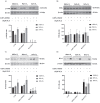HO-1 Limits the Efficacy of Vemurafenib/PLX4032 in BRAFV600E Mutated Melanoma Cells Adapted to Physiological Normoxia or Hypoxia
- PMID: 35740068
- PMCID: PMC9219655
- DOI: 10.3390/antiox11061171
HO-1 Limits the Efficacy of Vemurafenib/PLX4032 in BRAFV600E Mutated Melanoma Cells Adapted to Physiological Normoxia or Hypoxia
Abstract
Induction of heme oxygenase 1 (HO-1) favors immune-escape in BRAFV600 melanoma cells treated with Vemurafenib/PLX4032 under standard cell culture conditions. However, the oxygen tension under standard culture conditions (~18 kPa O2) is significantly higher than the physiological oxygen levels encountered in vivo. In addition, cancer cells in vivo are often modified by hypoxia. In this study, MeOV-1 primary melanoma cells bearing the BRAFV600E mutation, were adapted to either 5 kPa O2 (physiological normoxia) or 1 kPa O2 (hypoxia) and then exposed to 10 μM PLX4032. PLX4032 abolished ERK phosphorylation, reduced Bach1 expression and increased HO-1 levels independent of pericellular O2 tension. Moreover, cell viability was significantly reduced further in cells exposed to PLX4032 plus Tin mesoporphyrin IX, a HO-1 inhibitor. Notably, our findings provide the first evidence that HO-1 inhibition in combination with PLX4032 under physiological oxygen tension and hypoxia restores and increases the expression of the NK ligands ULBP3 and B7H6 compared to cells exposed to PLX4032 alone. Interestingly, although silencing NRF2 prevented PLX4032 induction of HO-1, other NRF2 targeted genes were unaffected, highlighting a pivotal role of HO-1 in melanoma resistance and immune escape. The present findings may enhance translation and highlight the potential of the HO-1 inhibitors in the therapy of BRAFV600 melanomas.
Keywords: HO-1; NK ligands; NRF2; hypoxia; melanoma; oxygen tension; physiological normoxia; response and/or resistance to therapy; target therapy.
Conflict of interest statement
The authors declare no conflict of interest.
Figures





Similar articles
-
HO-1 downregulation favors BRAFV600 melanoma cell death induced by Vemurafenib/PLX4032 and increases NK recognition.Int J Cancer. 2020 Apr 1;146(7):1950-1962. doi: 10.1002/ijc.32611. Epub 2019 Aug 24. Int J Cancer. 2020. PMID: 31376303
-
Pharmacodynamic characterization of the efficacy signals due to selective BRAF inhibition with PLX4032 in malignant melanoma.Neoplasia. 2010 Aug;12(8):637-49. doi: 10.1593/neo.10414. Neoplasia. 2010. PMID: 20689758 Free PMC article.
-
Vascular protection afforded by zinc supplementation in human coronary artery smooth muscle cells mediated by NRF2 signaling under hypoxia/reoxygenation.Redox Biol. 2023 Aug;64:102777. doi: 10.1016/j.redox.2023.102777. Epub 2023 Jun 7. Redox Biol. 2023. PMID: 37315344 Free PMC article.
-
Vemurafenib in patients with BRAF V600E mutation-positive advanced melanoma.Clin Ther. 2012 Jul;34(7):1474-86. doi: 10.1016/j.clinthera.2012.06.009. Epub 2012 Jun 27. Clin Ther. 2012. PMID: 22742884 Review.
-
Vemurafenib.Recent Results Cancer Res. 2014;201:215-25. doi: 10.1007/978-3-642-54490-3_13. Recent Results Cancer Res. 2014. PMID: 24756795 Review.
Cited by
-
Unraveling the role of hypoxia-inducible factors in cutaneous melanoma: from mechanisms to therapeutic opportunities.Cell Commun Signal. 2025 Apr 9;23(1):177. doi: 10.1186/s12964-025-02173-4. Cell Commun Signal. 2025. PMID: 40205422 Free PMC article. Review.
-
On the Therapeutic Potential of Heme Oxygenase-1 and Its Metabolites.Antioxidants (Basel). 2024 Oct 16;13(10):1243. doi: 10.3390/antiox13101243. Antioxidants (Basel). 2024. PMID: 39456496 Free PMC article.
-
The Cancer Antioxidant Regulation System in Therapeutic Resistance.Antioxidants (Basel). 2024 Jun 27;13(7):778. doi: 10.3390/antiox13070778. Antioxidants (Basel). 2024. PMID: 39061847 Free PMC article. Review.
-
PLX4032 resistance of patient-derived melanoma cells: crucial role of oxidative metabolism.Front Oncol. 2023 Jul 18;13:1210130. doi: 10.3389/fonc.2023.1210130. eCollection 2023. Front Oncol. 2023. PMID: 37534247 Free PMC article.
References
-
- Marengo B., Nitti M., Furfaro A.L., Colla R., Ciucis C.D., Marinari U.M., Pronzato M.A., Traverso N., Domenicotti C. Redox Homeostasis and Cellular Antioxidant Systems: Crucial Players in Cancer Growth and Therapy. Oxid. Med. Cell. Longev. 2016;2016:6235641. doi: 10.1155/2016/6235641. - DOI - PMC - PubMed
Grants and funding
LinkOut - more resources
Full Text Sources
Research Materials
Miscellaneous

